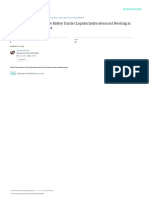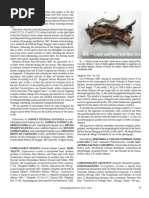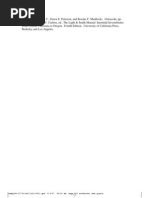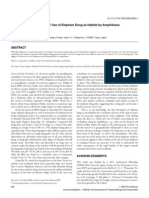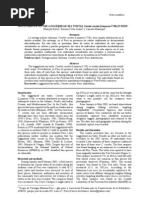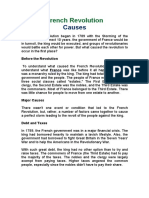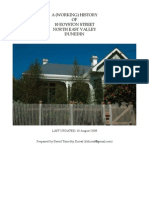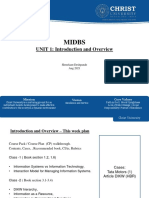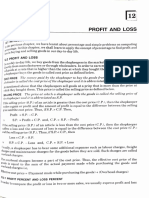Herpetoculture Notes 611-613 Dec 2016 HR47 (4) - Medres
Herpetoculture Notes 611-613 Dec 2016 HR47 (4) - Medres
Uploaded by
Uber SchalkeCopyright:
Available Formats
Herpetoculture Notes 611-613 Dec 2016 HR47 (4) - Medres
Herpetoculture Notes 611-613 Dec 2016 HR47 (4) - Medres
Uploaded by
Uber SchalkeOriginal Title
Copyright
Available Formats
Share this document
Did you find this document useful?
Is this content inappropriate?
Copyright:
Available Formats
Herpetoculture Notes 611-613 Dec 2016 HR47 (4) - Medres
Herpetoculture Notes 611-613 Dec 2016 HR47 (4) - Medres
Uploaded by
Uber SchalkeCopyright:
Available Formats
HERPETOCULTURE 611
Acknowledgments. — We would like to express our gratitude to Mathies, T. 2011. Reproductive cycles of tropical snakes. In R. D. Al-
Robert Meidinger of the World of Snakes, Alajuela, Costa Rica. We dridge, and D. M. Sever (eds.), Reproductive Biology and Phylog-
also thank Enrique La Marca and Daniel Lawson for their valuable eny of Snakes, pp. 511–550. CRC Press, Boca Raton, Florida.
contributions to the manuscript. Mole, R. R. 1924. The Trinidad snakes. Proc. Agr. Soc. Trinidad and
Tobago 14:363–369.
Literature Cited Ripa, D. 1994. The reproduction of the Central American bushmas-
ter (Lachesis muta stenophrys) and the blackheaded bushmaster
Alves, F. Q., A. J. S. Argolo, and G. C. Carvalho. 2014. Reproductive biol- (Lachesis muta melanocephala) for the first time in captivity. Bull.
ogy of the bushmaster Lachesis muta (Serpentes: Viperidae) in the Chicago Herpetol. Soc. 29:165–183.
Brazilian Atlantic Forest. Phyllomedusa 13:99–109. ———. 1999. Keys to understanding the bushmasters (genus Lache-
Amaral, A. 1926. On the oviparity of Lachesis muta Daudin, 1803. Co- sis Daudin 1803) Bull. Chicago Herpetol. Soc. 34:45–92.
peia 1925:93–94. ———. 2000. The bushmasters (genus Lachesis Daudin 1803): Mor-
Boyer, D. M., L. A. Mitchell, and J. B. Murphy. 1989. Reproduction and phology in evolution and behavior. CD-ROM. Ripa Ecologica,
husbandry of the bushmaster Lachesis muta muta at the Dallas Wilmington, North Carolina.
Zoo. Int. Zoo Ybk. 28:190–194. ———. 2001. The bushmasters (genus Lachesis Daudin 1803): Mor-
Campbell, J. A., and W. W. Lamar. 2004. The Venomous Reptiles of the phology in evolution and behavior. CD-ROM. Ripa Ecologica,
Western Hemisphere. Vol. I. Comstock Publishing Associates, Itha- Wilmington, North Carolina.
ca, New York. 976 pp. Rossi, J. V. 2006. General husbandry and management. In D. Mader
Corrales, G., R. Meidinger., S. Rodríguez., D. Chacón, and A. Gómez. (ed.), Reptile Medicine and Surgery (2nd ed.), pp. 25–41. Elsevier
2014. Reproduction in captivity of the Central American bush- Saunders, St. Louis, Missouri.
master (Lachesis stenophrys, Serpentes: Viperidae), in Costa Rica. Sánchez, D. 2000. Herpetofauna del cerro La Laguna, macizo del
Cuad. Herpetol. 28:137–139. Turimiquire, municipio Freites, estado Anzoátegui, Venezuela. Te-
Eisele, B.R. 2009. Propagation of the South American bushmaster sis de Licenciatura, Facultad de Agronomía, Universidad Central
(Lachesis muta muta) at the Jacksonville Zoo and Gardens. IRCF de Venezuela. 78 pp.
Reptil. Amphib.16:182–189. ———, L. De Sousa, L. Esqueda, and J. Manzanilla. 2004. Especie nueva
Fernandes, D. S., F. L. Franco, and R. Fernandes. 2004. Systematic re- de Atractus (Serpentes: Colubridae) del Macizo del Turimiquire,
vision of the genus Lachesis Daudin, 1803 (Serpentes, Viperidae). tramo oriental de la Cordillera de la Costa, Venezuela. Saber 16:89–
Herpetologica 60:245–260. 95.
Greene, H. W. 1997. Snakes: The Evolution of Mystery in Nature. Uni- Souza, R. 2007. Reproduction of the Atlantic bushmaster (Lachesis
versity of California Press, Berkeley, California. 351 pp. muta rhombeata) for the first time in captivity. Bull. Chicago Her-
———, and M. A. Santana. 1983. Field studies of hunting behavior by petol. Soc. 42:41–43.
bushmasters. Amer. Zool. 23:897. Turner, E., R. Carmichael, and R. Souza. 2008. Dialogues on the Tao of
Henao, A. M., and G. Corrales. 2015. First report of the reproduction in Lachesis. Bull. Chicago Herpetol. Soc. 43:157–164.
captivity of the Chocoan bushmaster, Lachesis acrochorda (García, Vial, J. L. and J. M. Jimenez-Porras. 1967. The ecogeography of the
1896). Herpetol. Notes 8:315–320. bushmaster, Lachesis muta, in Central America. Amer. Midl. Nat.
Lancini, V. A. 1986. Serpientes de Venezuela. 2nd ed. Talleres Graficas 78:182–187.
Armitano, Caracas. 262 pp.
HERPETOCULTURE NOTES
TESTUDINES — TURTLES a carapace covered with soft skin that lacks keratinized scutes.
The carapace can range from olive to black in coloration and
CARRETOCHELYS INSCULPTA (Fly River Turtle). CLEANING is counter shaded by a cream colored plastron. Carettochelys
MUTUALISM. Cleaning mutualism is a well-known symbiotic insculpta are fully aquatic and have four flipper-like limbs
relationship frequently observed in the wild. This interaction resembling the limbs of a sea turtle. They can also be identified
involves a cleaner, a host, and often times may take place at a by their long, snorkel-like snout (Cann 1998. Australian
cleaning station. A cleaning event typically involves the cleaner Freshwater Turtles. Beaumont Publishing, Singapore. 292 pp.)
species removing ectoparasites from a client species (Losey et al. A single male C. insculpta was observed over a period of
1994. Copeia. 1994:684–690). The cleaner may also feed on the skin four non-consecutive days in its enclosure at the Smithsonian
of the host to remove mucus or diseased skin (Floeter et al. 2007. National Zoo in Washington, District of Columbia, USA. The
J. Anim. Ecol. 76[1]:105–111). Cleaner species often linger around C. insculpta was housed with a Pterygoplichthys gibbiceps
an area known as the cleaning station, while clients approach (Leopard Pleco) during the observations. Carettochelys
such a place specifically to be cleaned. Cleaners may range from insculpta and P. gibbiceps do not occur naturally together in
specialized fish to birds (Losey 1972. Copeia. 1972:820–833; Poulin the wild; C. insculpta is endemic to parts of Australia and New
and Grutter 1996. Bioscience. 46[7]:512–517). Meanwhile clients Guinea, while P. gibbiceps naturally occurs in South America.
can include any species in need of ectoparasite removal, typically Nonetheless, a presumably symbiotic cleaning mutualism was
a species larger than the cleaner. Cleaning mutualisms occur regularly observed among these individuals.
among various species; however, most documented instances The C. insculpta was often seen posing during a cleaning
occur in marine environments (Floeter et al. 2007, op. cit.). event (Fig. 1A). Posing is a behavior common to clients in
Carettochelys insculpta is an omnivorous turtle found in cleaning mutualisms. During posing, the client species
freshwater streams and rivers in the Northern Territory of assumes a position in anticipation of a cleaning. This position
Australia and the southern part of Papua New Guinea. They have is only assumed during a cleaning interaction (Losey 1972, op.
Herpetological Review 47(4), 2016
612 HERPETOCULTURE
Fig. 1. A) The Carettochelys insculpta seen posing during a cleaning event. B) The C. insculpta is seen with limbs stretched out and head lifted
upward. C & D) The C. insculpta can be observed lifting a portion of its plastron from the substrate as Pterygoplichthys gibbiceps moved in to
clean the area exposed underneath. E) The P. gibbiceps was observed resting on the carapace of the turtle.
cit.). The C. insculpta was observed posing for the fish five times event (Poulin and Grutter 1996, op. cit.), which was observed
out of seven cleaning events. As seen in Fig. 1B, the limbs of multiple times. Additionally, a possible cleaning station was
the C. insculpta were stretched out and the head lifted upward, identified in the enclosure. A single branch was frequented by
a pose that has been previously observed among clients. both individuals a large percentage of the observation time.
Similarly, clients often remain motionless during a cleaning Cleaning events were often observed at this site, indicating that
Herpetological Review 47(4), 2016
HERPETOCULTURE 613
this branch may very well be a cleaning station in the enclosure. It is necessary to speculate why this cleaning mutualism
The use of this cleaning station was noted approximately occurred since C. insculpta and P. gibbiceps do not live together
seventy five times during the observations. in the wild. There are several species of fish that may fill the
A majority of the cleanings were instigated by the C. insculpta same niche as P. gibbiceps would that inhabit the Fly-Strickland
by nudging the fish to indicate the desire for a cleaning. The C. river system in New Guinea where C. insculpta is found (Roberts
insculpta was also observed shifting the direction of its body, 1978. Smithsonian Contrib. to Zoo. 281). However, there has not
moving limbs, or corralling the fish towards different parts of its yet been a documented cleaning mutualism between fish and C.
body. When the turtle would shift positions or move its limbs this inscuplta in the wild.
resulted in the fish cleaning those areas that were adjusted. In An alternate or additional explanation for this cleaning
Fig. 1C and Fig. 1D, the turtle can be observed lifting a portion of mutualism is simply the desire of this C. insculpta to be cleaned.
its plastron from the substrate and P. gibbiceps having moved in It is well known that C. insculpta is a host to ectoparasites found
to clean the area exposed underneath the turtle. The P. gibbiceps on its skin (Saumure and Doody 2000. Herpetol. Rev. 31[4]:237–
was observed cleaning the carapace, plastron, limbs, neck, chin, 238). It is possible that the turtle’s need to be cleaned stems
head, and around the cloaca during most cleaning events. from this natural tendency to get rid of these ectoparasites. This
Interestingly, the P. gibbiceps was observed on several may explain why the turtle initiated the majority of the cleaning
occasions simply resting on the turtle, either on a limb or the events.
shell (Fig. 1E). This resting behavior was observed a total of Because cleaning mutualisms have been known to occur
ten times throughout the observational periods; both during a among different species in captivity (Poulin and Grutter 1996,
cleaning event and when no cleaning event was in progress. The op. cit.), it is possible that a cleaning mutualism will also occur
reason for this behavior is unclear; this likely does not constitute with another individual of P. gibbiceps. Further study will be
cleaning behavior, but it is an interesting aspect of the possible needed to determine if the relationship observed between these
symbiotic relationship between these individuals. two individuals is specific to them or if the same relationship
The observation period ended when the P. gibbiceps was will result with a different fish. In the future P. gibbiceps or
found dead in the enclosure. It is unknown whether the C. another cleaner fish from within the same range of C. insculpta
insculpta decided to consume the P. gibbiceps or whether it died should be placed in the enclosure. The individuals should be
of another cause. It is well known that cheating clients exist in observed in the same manner as above. Initial interactions and
seemingly symbiotic relationships. A cheating client will take characteristics such as presence of a cleaning station and client
advantage of the cleaner by consuming it (Poulin and Grutter posing should be noted in the observations.
1996, op. cit.). The C. insculpta was not observed killing the P. ALESSANDRA CHIOTTI and MATT NEFF, Department of Herpetol-
gibbiceps, however the turtle was observed consuming parts of ogy, Smithsonian National Zoological Park, Washington, DC 20008, USA
the fish after it had died. The P. gibbiceps may have already died (e-mail: neffm@si.edu)
before consumption by the turtle. It is unclear what occurred.
Herpetological Review 47(4), 2016
You might also like
- Buy Zimbabwe Brand Manual FinalDocument10 pagesBuy Zimbabwe Brand Manual FinalRobert Garai MugandaNo ratings yet
- Pe ExamDocument10 pagesPe ExamVatova JarrandNo ratings yet
- Shis 124Document22 pagesShis 124ebenezergonzalez11No ratings yet
- BothropsDocument3 pagesBothropsYostin AñinoNo ratings yet
- 1 PBDocument3 pages1 PBYeison Calizaya MeloNo ratings yet
- Helicops Leopardinus: Distribution Extension,: Notes On Geographic DistributionDocument2 pagesHelicops Leopardinus: Distribution Extension,: Notes On Geographic DistributionChantal AranNo ratings yet
- Helicop Angulatus PDFDocument2 pagesHelicop Angulatus PDFChantal AranNo ratings yet
- Philodryas Patagoniensis - Diet - Lopez (2003)Document2 pagesPhilodryas Patagoniensis - Diet - Lopez (2003)Danilo CapelaNo ratings yet
- CheckList Article 53857 en 1Document4 pagesCheckList Article 53857 en 1Jonathan DigmaNo ratings yet
- Aguilar Herpetology Notes Volume6 Page89-90Document2 pagesAguilar Herpetology Notes Volume6 Page89-90Victor Isaac Perez soteloNo ratings yet
- Scharer (2003) A Survey of The Epibiota of Eretmochelys Imbricata (Testudines - Cheloniidae) of Mona Island, Puerto RicoDocument5 pagesScharer (2003) A Survey of The Epibiota of Eretmochelys Imbricata (Testudines - Cheloniidae) of Mona Island, Puerto RicoMurat OzaydinliNo ratings yet
- 1MorayRobinson BlindturtleDocument3 pages1MorayRobinson BlindturtleFátima GuzmánNo ratings yet
- C B - A R A. O: Campus Earth University, Mercedes, Limón, Costa RicaDocument3 pagesC B - A R A. O: Campus Earth University, Mercedes, Limón, Costa RicaspizaetuscarnivoroNo ratings yet
- bertoluci1998Document6 pagesbertoluci1998Camila KambleviciusNo ratings yet
- 2 Mora y Robinson Loxocemus - LepidochelysDocument2 pages2 Mora y Robinson Loxocemus - LepidochelysJosé MoraNo ratings yet
- Clarc Usena 2016Document10 pagesClarc Usena 2016francibelkNo ratings yet
- Powel Et Al (2010) - Sphaerodactylus Phyzacinus PDFDocument4 pagesPowel Et Al (2010) - Sphaerodactylus Phyzacinus PDFKlaus FischerNo ratings yet
- Maia Et Al. 2011 Xenodon Neuwiedi DietDocument1 pageMaia Et Al. 2011 Xenodon Neuwiedi DietThiago Maia CarneiroNo ratings yet
- Jaguarundi Herpailurus Yagoaroundi Notes in The Caribbean Lowlands of Belize and Guatemala Mccarthy 1992Document5 pagesJaguarundi Herpailurus Yagoaroundi Notes in The Caribbean Lowlands of Belize and Guatemala Mccarthy 1992María José TorallaNo ratings yet
- Ecology and Evolution of Phytotelm-Breeding AnuransDocument84 pagesEcology and Evolution of Phytotelm-Breeding AnuransFabricius Domingos100% (1)
- Nothopsis Snake NoteDocument2 pagesNothopsis Snake NoteArco Iris CallejaNo ratings yet
- Sibonius Is A Diurnal, Actively Foraging Snake Inhabiting TheDocument2 pagesSibonius Is A Diurnal, Actively Foraging Snake Inhabiting Thelaspiur22blues7327No ratings yet
- Cuellar - The Tatujeikurajoyava Chlamyphorus Retusus in The Izozog Communities of The Bolivian Gran ChacoDocument3 pagesCuellar - The Tatujeikurajoyava Chlamyphorus Retusus in The Izozog Communities of The Bolivian Gran ChacoHuáscar Bustillos CayojaNo ratings yet
- Chavez Et Al 2010 CophosaurusDocument1 pageChavez Et Al 2010 CophosaurusJero ChávezNo ratings yet
- Ojeda 1993 PDFDocument6 pagesOjeda 1993 PDFSofia Andrea Fajardo TrujilloNo ratings yet
- Dixon y Soini (1977) The Reptiles of The Upper Amazon Basin, Iquitos Region, Perú. Part II Crocodilians, Turtles and SnakesDocument93 pagesDixon y Soini (1977) The Reptiles of The Upper Amazon Basin, Iquitos Region, Perú. Part II Crocodilians, Turtles and SnakesDiego LoboNo ratings yet
- Traditional Geog Range Ethnobotanical CordylineDocument15 pagesTraditional Geog Range Ethnobotanical CordylineChitra BhaskarNo ratings yet
- A Review of the Middle American Tree Frogs of the Genus PtychohylaFrom EverandA Review of the Middle American Tree Frogs of the Genus PtychohylaNo ratings yet
- 1 Mora y Robinson-Blind TurtleDocument2 pages1 Mora y Robinson-Blind TurtleJosé MoraNo ratings yet
- Baumgartner & Greenberg 1985Document23 pagesBaumgartner & Greenberg 1985DIEGO ANDRES CADENA DURANNo ratings yet
- Bañuelos-Alamillo and Carbajal-MaŕquezDocument3 pagesBañuelos-Alamillo and Carbajal-MaŕquezMario HerreraNo ratings yet
- Laspiur & Acosta-LIOLAEMUS INACAYALI-Maximum Size-2008Document1 pageLaspiur & Acosta-LIOLAEMUS INACAYALI-Maximum Size-2008laspiursaurusNo ratings yet
- Almiron Et Al 2011 A Failed Swallowing Attempt Upon A Crab-Eating FoxDocument4 pagesAlmiron Et Al 2011 A Failed Swallowing Attempt Upon A Crab-Eating FoxEverton MirandaNo ratings yet
- Predation of Rhinella Ornata (Anura, Bufonidae) by The AlienDocument3 pagesPredation of Rhinella Ornata (Anura, Bufonidae) by The Aliendavid.asantos01No ratings yet
- An Unusual Prey Item For The Yellow Tail Cribo Drymarchon Corais Boie 1827, in The Brazilian SavannahDocument4 pagesAn Unusual Prey Item For The Yellow Tail Cribo Drymarchon Corais Boie 1827, in The Brazilian SavannahcomandocrawNo ratings yet
- Key To The Ostracods 2007Document31 pagesKey To The Ostracods 2007Lemon Tree100% (1)
- Mammalian Biology: Original InvestigationDocument13 pagesMammalian Biology: Original InvestigationManuel RuizNo ratings yet
- Tiburon Come MimusDocument3 pagesTiburon Come MimusHector LealNo ratings yet
- 10 1670@18-042 PDFDocument15 pages10 1670@18-042 PDFAlexander McKelvyNo ratings yet
- Amphibians and Reptiles of La Selva, Costa Rica, and the Caribbean Slope: A Comprehensive GuideFrom EverandAmphibians and Reptiles of La Selva, Costa Rica, and the Caribbean Slope: A Comprehensive GuideRating: 3.5 out of 5 stars3.5/5 (4)
- Key To Amphipoda: Paratanais Euelpis Barnard (Tanaidacea) - Arkiv. For Zool. 1: 357-360Document74 pagesKey To Amphipoda: Paratanais Euelpis Barnard (Tanaidacea) - Arkiv. For Zool. 1: 357-360OanaNo ratings yet
- Laspiur Et Al.2012. Philodryas Trilineta. Diet. HR-2012!43!1-p153Document2 pagesLaspiur Et Al.2012. Philodryas Trilineta. Diet. HR-2012!43!1-p153laspiur22blues7327No ratings yet
- Demo 220401120900Document19 pagesDemo 220401120900James ZayneNo ratings yet
- Bearez 1998 - FishingPoisonSeaEnvironmentSalango PDFDocument6 pagesBearez 1998 - FishingPoisonSeaEnvironmentSalango PDFNayelitzin J. CanoNo ratings yet
- 10 1016@j Jasrep 2019 03 032Document9 pages10 1016@j Jasrep 2019 03 032Anonymous VqDPRFNo ratings yet
- New Distributional Records of Amphibians in The Andes of EcuadorDocument2 pagesNew Distributional Records of Amphibians in The Andes of EcuadorOreomanesNo ratings yet
- Reviewof in Searchof Lost Frogsby Robin MooreDocument3 pagesReviewof in Searchof Lost Frogsby Robin MoorezehruhuwuwuNo ratings yet
- Hoplosternum - Littorale - CascaduDocument3 pagesHoplosternum - Littorale - Cascadue.watakidoNo ratings yet
- William BaleeDocument61 pagesWilliam BaleeMariusz KairskiNo ratings yet
- 07-Christofoletti (2005) - Ecologia Trófica de UcidesDocument8 pages07-Christofoletti (2005) - Ecologia Trófica de UcidesVidènia da silva Lopes cambulaNo ratings yet
- Emparanza Et Al. 2011 MBRDocument3 pagesEmparanza Et Al. 2011 MBRrulloa1971No ratings yet
- Elephant Dung - EcosystemDocument2 pagesElephant Dung - EcosystemmeshikaNo ratings yet
- Notes On The Courtship Behavior of Aplastodiscus ADocument9 pagesNotes On The Courtship Behavior of Aplastodiscus ABeatriz BritoNo ratings yet
- Callicebus Caquetensis Primate ConservationDocument9 pagesCallicebus Caquetensis Primate ConservationMico MaconheiroNo ratings yet
- Oliveira e Vasconcelos. 2017Document8 pagesOliveira e Vasconcelos. 2017Bárbara MaiaNo ratings yet
- Riley, 1995 Growth and Morphology of Larval and Juvenile Captive BredDocument7 pagesRiley, 1995 Growth and Morphology of Larval and Juvenile Captive BredWaldo Gutieg BerceNo ratings yet
- Parker - Registro Inusual en El Norte de BoliviaDocument20 pagesParker - Registro Inusual en El Norte de BoliviaMiguel Montenegro AvilaNo ratings yet
- P Ocellatus (Lynch&Burrowes1990)Document31 pagesP Ocellatus (Lynch&Burrowes1990)Esteban Garzon FrancoNo ratings yet
- Kelez Etal Loggerheads in Peru EcolAplic2003Document2 pagesKelez Etal Loggerheads in Peru EcolAplic2003tortugamarinaNo ratings yet
- Amplexo Inusual Dendropsophus ColombianusDocument2 pagesAmplexo Inusual Dendropsophus ColombianusJuan Camilo MantillaNo ratings yet
- Biodiversity Not Just Lots of Fish in The Sea 2012 Current BiologyDocument2 pagesBiodiversity Not Just Lots of Fish in The Sea 2012 Current Biology7fkqx7zh7pNo ratings yet
- A Field Study of the Kansas Ant-Eating Frog, Gastrophryne olivaceaFrom EverandA Field Study of the Kansas Ant-Eating Frog, Gastrophryne olivaceaNo ratings yet
- Iso 3210 2010Document9 pagesIso 3210 2010Jigar GalaNo ratings yet
- Siriusxm For 3 Mos. For $1: America'S Environmental SchoolDocument5 pagesSiriusxm For 3 Mos. For $1: America'S Environmental SchoolOo PasNo ratings yet
- GV CommandLineDocument9 pagesGV CommandLineKaiser BullaNo ratings yet
- ISSJE-MKU Student Attachment Assessment Forms (2021)Document4 pagesISSJE-MKU Student Attachment Assessment Forms (2021)henrykibe01No ratings yet
- French Revolution Causes. Reading CompDocument4 pagesFrench Revolution Causes. Reading CompamayalibelulaNo ratings yet
- Couns Interview Rating Form CIRF SamDocument4 pagesCouns Interview Rating Form CIRF Samkarmstrong3No ratings yet
- Flange 150#Document5 pagesFlange 150#Ashok KumarNo ratings yet
- Burj Khalifa Fire ControlDocument15 pagesBurj Khalifa Fire ControlScribdTranslationsNo ratings yet
- CUET Practice Questions: Numerical AbilityDocument6 pagesCUET Practice Questions: Numerical AbilityPRAKHAR MUNDRANo ratings yet
- A History of Royston StreetDocument10 pagesA History of Royston Streetdtduval2258No ratings yet
- Introduction To Management-Foundations of Individual BehaviourDocument4 pagesIntroduction To Management-Foundations of Individual BehaviourDhanis ParamaguruNo ratings yet
- Robert Martinez Stock GuidDocument6 pagesRobert Martinez Stock Guidkuwar.shubham18No ratings yet
- Professional EthicsDocument5 pagesProfessional EthicsAshish DhangarNo ratings yet
- Project ProposalDocument18 pagesProject ProposaldhanushNo ratings yet
- Midbs: UNIT 1: Introduction and OverviewDocument30 pagesMidbs: UNIT 1: Introduction and Overviewsahil suranaNo ratings yet
- QWERTY On GamesDocument10 pagesQWERTY On GamesPradipta DashNo ratings yet
- Consumer Finance NewstorelistDocument46 pagesConsumer Finance Newstorelistnikhil jainNo ratings yet
- Irradiation in Food ProcessingDocument32 pagesIrradiation in Food ProcessingKishan KoyaniNo ratings yet
- Model, Render, Animate: Houdini FoundationsDocument24 pagesModel, Render, Animate: Houdini FoundationsPlanemoNo ratings yet
- CH RWSR in GabionWall Mumbai PuneExpressway MaharashtraDocument4 pagesCH RWSR in GabionWall Mumbai PuneExpressway MaharashtraManoj RautNo ratings yet
- Transaction Internals: Julian Dyke Independent ConsultantDocument41 pagesTransaction Internals: Julian Dyke Independent ConsultantdbakevinNo ratings yet
- pc45 Komatsu 2020Document12 pagespc45 Komatsu 2020LeoLeoNo ratings yet
- COA Booth's Multiplication AlgorithmDocument1 pageCOA Booth's Multiplication AlgorithmshinchoneeNo ratings yet
- Genie Z45-25RT - Z45-25 J RT - Ed.2006Document2 pagesGenie Z45-25RT - Z45-25 J RT - Ed.2006mimariusNo ratings yet
- Advanced Google Dorking Commands CybraryDocument11 pagesAdvanced Google Dorking Commands CybraryMarzee0nENo ratings yet
- Itm Lab QuestionsDocument12 pagesItm Lab QuestionsBhagya RàhéjäNo ratings yet
- Iapmo 4197 PDFDocument15 pagesIapmo 4197 PDFIvan FlorezNo ratings yet
- NewspaperDocument1 pageNewspaperInnocent OkekeNo ratings yet











